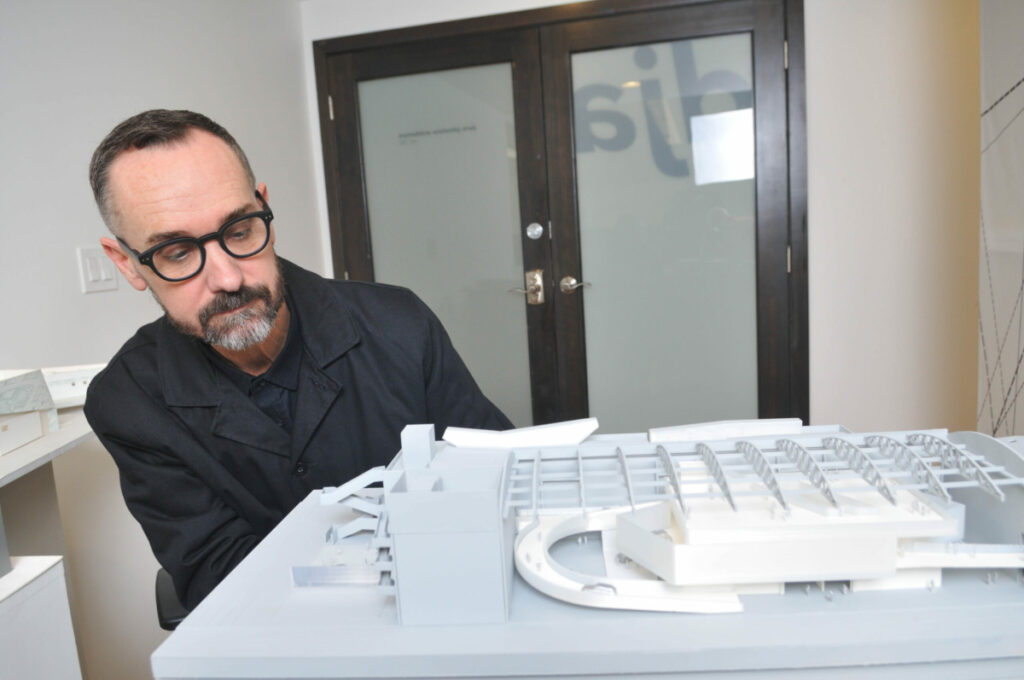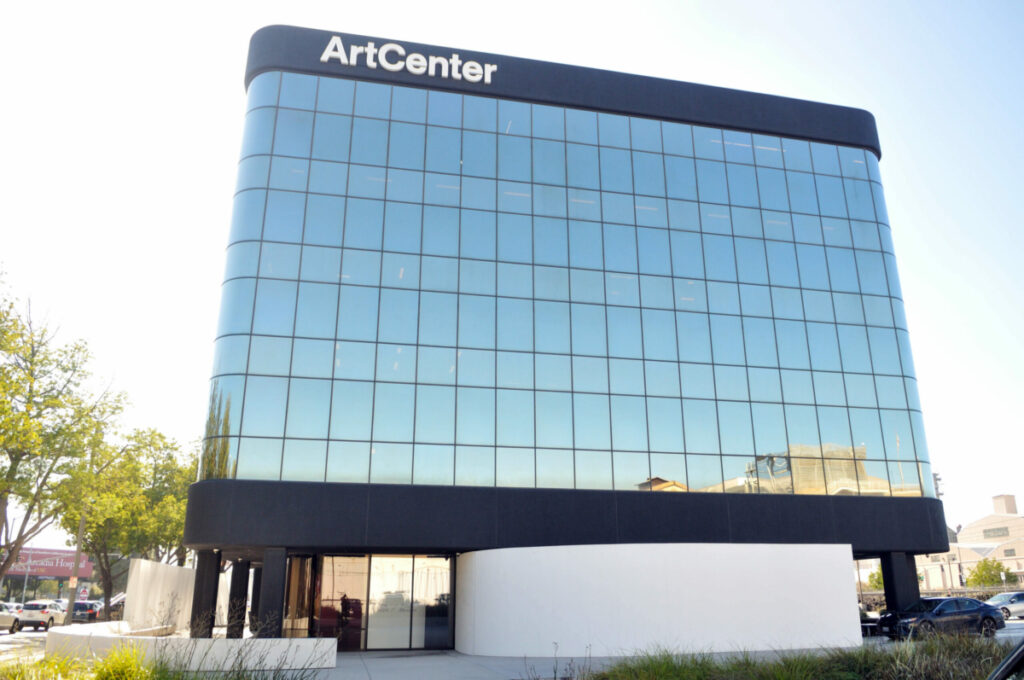Stroll around the two Pasadena campuses of ArtCenter College of Design and peer inside some of the buildings. Chances are 50% that you will be looking at the design work of Darin Johnstone Architects, a boutique firm in nearby Eagle Rock.
Over the past decade, Darin Johnstone Architects, or DJA, has designed roughly half the educational and performance spaces on the main and downtown campuses of ArtCenter College, including inside the iconic “bridge building” on the main campus and, most recently, the conversion of an old wind tunnel facility building near downtown Pasadena into a transportation design instruction center.
Indeed, DJA has become ArtCenter College’s “go-to” firm as it seeks to reimagine and expand its education and performance facilities. And work from ArtCenter College now comprises more than three-fourths of DJA’s $1.2 million in annual revenue.
But now, DJA is ready to diversify beyond the institution that has become so integral to its being – and plans to use the experience it has gained at ArtCenter College to enter new markets.
“We have reached what I hope is an inflection point for our business,” founder and principal Darin Johnstone said. “We now have a big focus on diversification of our client base, entering new project markets and expanding to other areas in Southern California.”

Residential roots
Until now, DJA has supplemented its ArtCenter College work with relatively small-scale residential projects, a niche Johnstone has focused on since before he founded the firm in 2004.
In the late 1990s, Johnstone teamed up with fellow architect Scott Parker, a friend from his days as an undergraduate at California Polytechnic University Pomona, to launch his first architectural firm, which focused on residential projects. But in 2003 Parker left to join a larger firm and Johnstone decided to start another firm – this time on his own. He bootstrapped the firm with residential projects, supplementing his income with a teaching position at the Southern California Institute of Architecture (SCI-Arc) in downtown Los Angeles.
One of the first projects DJA worked on was for a client from Johnstone’s first firm who had just purchased a home on the Palos Verdes Peninsula designed by the late Frank Lloyd Wright Jr., son of the famed architect. The building, with its bold, flattened design, jutted out from a slope, offering panoramic ocean views.
“We had intentions to upgrade where we could, but the overall mission was to preserve the building and its intent,” the client, Matt Hill, said. Hill is chief executive of Melbourne, Australia-based sportswear company Globe International Ltd., which has its U.S. headquarters in Carson.
Hill has since used DJA for other, mostly residential projects, including a villa in Ojai. He said that unlike some architects he’s worked with, Johnstone puts the wishes of his clients first.
“It’s not about being a vanity project for him,” Hill said.
ArtCenter transformation DJA could have kept on with designing small residential properties.
“I have a sole proprietor mentality,” Johnstone said. “I’ve always known the scale of my business.”
But in 2013, Johnstone’s meeting with a former student of his from Cal Poly Pomona changed the course of the firm. That former student, Rollin Homer, played a key role in facilities development at ArtCenter College; he is now vice president of facilities and campus planning for the school.
Homer invited Johnstone and his DJA firm to respond to a request for proposals that the college had just put out for repurposing a building the school had just purchased in downtown Pasadena for fine art and illustration instruction.
DJA won the bid and so began the collaboration with ArtCenter College.
“It’s been a pleasure working with the DJA team for almost a decade as they transform ArtCenter’s teaching facilities across our campuses,” Homer said in an emailed statement. “Our rich history with Darin (Johnstone) and his team continues to be strengthened by the firm’s approach: They are wonderful collaborators and listen closely to our community’s needs in order to thoughtfully respond with intelligent, resourceful design solutions that contribute to a transformational educational experience.”
Johnstone said the most challenging project at ArtCenter is the conversion of the wind-tunnel facility into a center for instruction in transportation design – the firm’s largest project at Art Center to date.
“It really was designed and constructed as a wind-tunnel facility owned and operated by Caltech for the test performance of aircraft,” he said, noting that the facility was decommissioned in the 1960s.
“Part of what has made it so challenging is that we found some crazy things under the concrete slab, including large-scale foundations and basements that we didn’t know existed,” he said.
Those discoveries have forced some redesigns in the project, which is now in the construction phase.

According to Stewart Reed, department chair for graduate and undergraduate design at ArtCenter, the ultimate aim of the design is to have the instruction space evoke automotive design studios that many of the students will likely end up working in.
Need for diversification
The dominance of ArtCenter as a client for Darin Johnstone Architects is not unusual for a small boutique firm, according to Scott Parker, the aforementioned friend and brief business partner of Darin Johnstone 20 years ago who is now design director at Studio One Eleven, a 50-person architecture firm in Long Beach.
“Reliance on one large customer is somewhat typical in this field,” Parker said. “He (Johnstone) got lucky and latched on to a particular client with lots of work. Once you do a good job for them, they give you more work.”
But Parker pointed out the obvious shortcoming of such a relationship: At some point, the work from that large customer will begin to wane. And, he said, unless the firm has a diversification strategy in place, it could wither away as the work from that customer winds down.
Parker said there are several options for DJA to diversify.
“The next stage for him would be to go after RFPs (requests for proposals) with other large educational institutions,” Parker said. “Something from a school the size of USC, for example.”
If that strategy doesn’t work, Parker said DJA could try to latch on as a specialty architectural subcontractor on major design projects. He noted that most of DJA’s projects have been adaptive reuse of existing facilities.
“DJA brings agile design thinking to the table,” he said. “Too often, larger architectural firms get stuck in a certain design mode.”
Johnstone said he is open to all these possibilities and others, including broadening the geographic focus to other parts of Southern California, forming relationships with new construction contractors to go after more “ground up” design projects, and also trying to capture some of the burgeoning affordable housing design work.
“Whatever the strategy is – and maybe it’s a combination of several of these – the focus has to be on diversification of our client base and markets,” he said. “That’s crucial in order for our firm to be healthy and continue on.”
